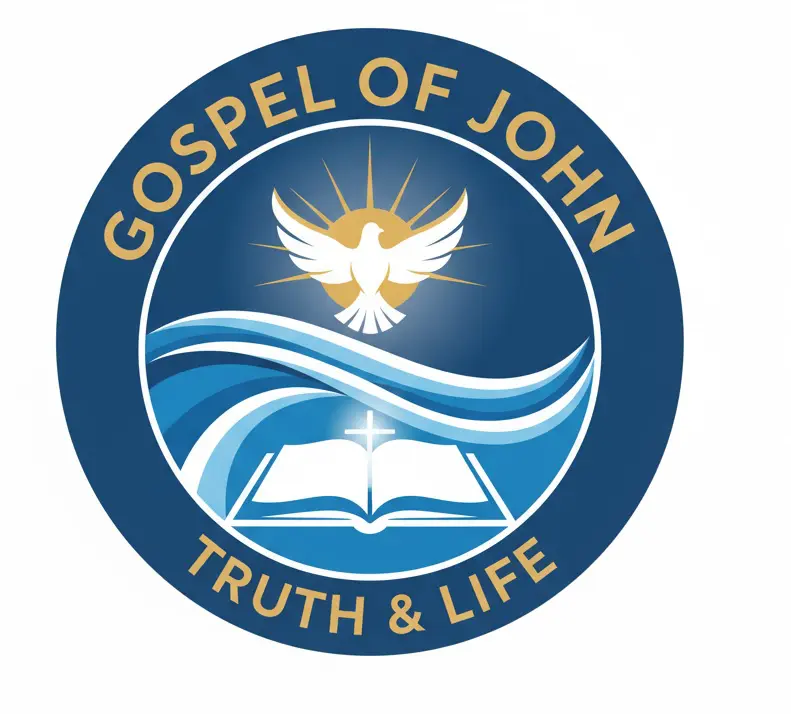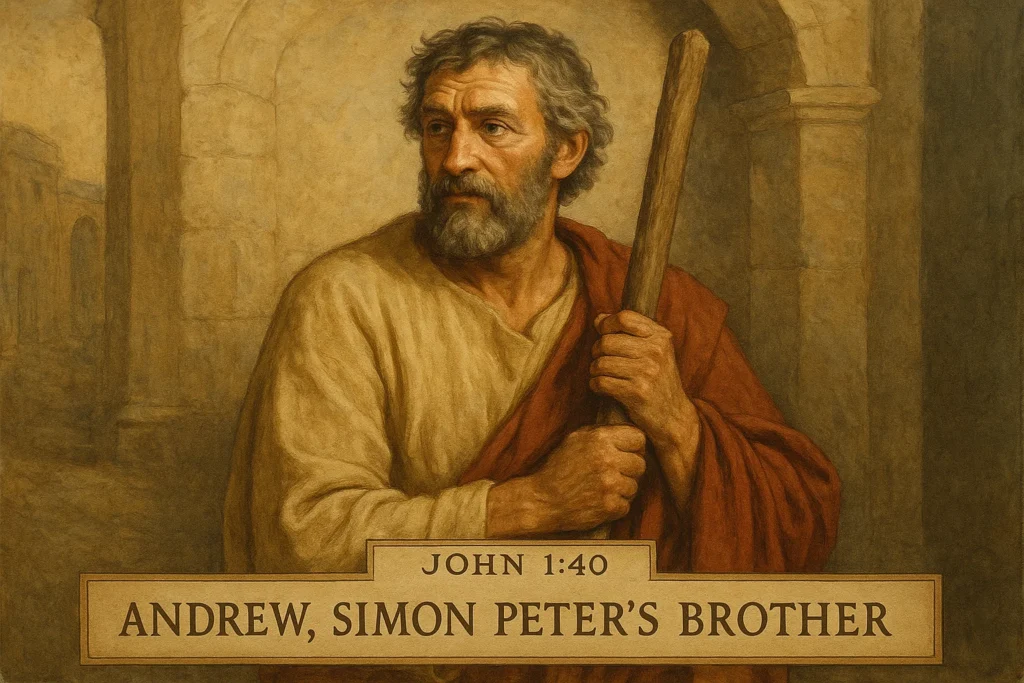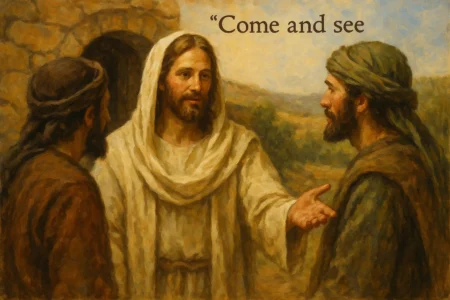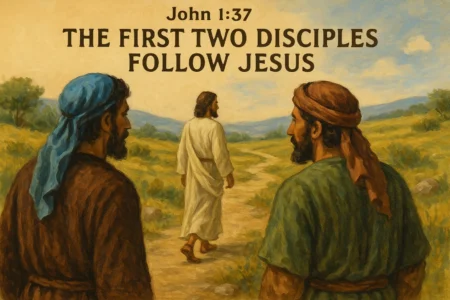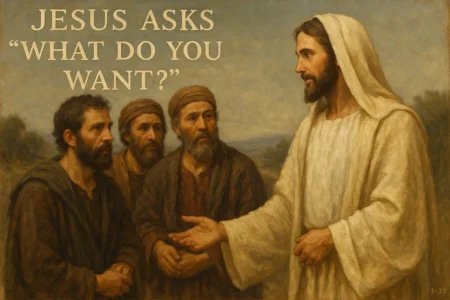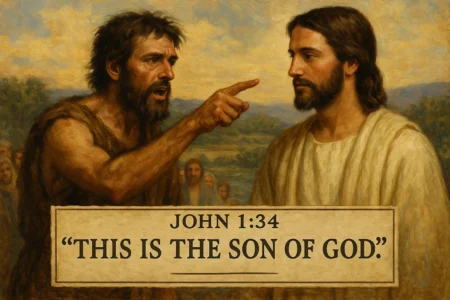For the first 18 years of my life, I was “Steve’s little brother.” Steve was the athlete, the outgoing one, the guy everyone knew. I was the quiet bookworm. When people met me, their first connection was always, “Oh, you’re Steve’s brother!” It wasn’t mean, but for a long time, my identity felt like a footnote to his. I love my brother, but I wrestled with being “the other brother.”
Maybe that’s why I’ve always felt a pull toward the man we meet in John 1:40.
The verse is simple, almost a passing detail: “One of the two who heard John speak and followed Jesus was Andrew, Simon Peter’s brother.”
It’s a name tag. An identifier. But locked inside that straightforward sentence is one of the most profound moments in history. This isn’t just trivia. It’s the story of the first domino. So, let’s talk about John 1:40 explained—not just as a verse, but as the origin story of the Christian faith’s most prominent disciple, all thanks to his overlooked brother.
We’re going to dive deep into the context, the man, and the earth-shattering legacy that started with one simple introduction.
More in John Chapter 1 Category
Key Takeaways
- John 1:40 identifies Andrew as one of the very first disciples of Jesus, who was previously a disciple of John the Baptist.
- The verse explicitly names Andrew and identifies him by his relationship to his more famous brother, Simon Peter.
- Andrew’s immediate action after meeting Jesus is to find his brother Peter, making him the first “evangelist” or “connector” in the Gospel.
- The other, unnamed disciple who was with Andrew is widely believed to be John, the author of the Gospel.
- This moment signifies the crucial transition from John the Baptist’s ministry to Jesus’s ministry.
- Andrew’s story demonstrates the immense power of a “background” role, proving that one’s greatest legacy might be in recognizing and platforming someone else.
So, What’s the Scene Just Before This Verse?
You can’t get the punch of John 1:40 without knowing what happened in John 1:39. Context is everything. This isn’t happening in a vacuum. The air in Judea is electric. People are desperate. They’re living under the boot of Roman occupation, and they are clinging to ancient prophecies of a Messiah—a Rescuer, a King who would restore Israel.
Into this powder keg walks John the Baptist. He’s a wild man, a radical prophet preaching repentance in the desert. He’s attracting huge crowds. People are wondering, “Is he the one?”
Two of the men watching him are his own disciples. One is named Andrew. The other is unnamed (we’ll get to him). They’ve committed their lives to John’s message. But then, John does something incredible. He sees his cousin, Jesus of Nazareth, walking by.
John stops. He points. He cries out with a voice that must have echoed in their bones: “Behold, the Lamb of God, who takes away the sin of the world!”
What Did That “Lamb of God” Title Even Mean?
For Andrew and the other disciple, this wasn’t poetry. It was a code. “Lamb of God” was a loaded phrase. It hit two huge notes for a first-century Jew:
- The Passover Lamb: The unblemished lamb whose blood was painted on the doorposts in Egypt, saving the Israelites from the angel of death. It was the symbol of protection and liberation.
- The Sacrificial Lamb: The lambs sacrificed daily in the Temple for the atonement of sins. It was the symbol of forgiveness.
So when John pointed at Jesus and said, “There he is. That’s the one,” he was essentially screaming to his followers, “This is the ultimate sacrifice. This is our liberation. Everything I’ve been preaching about? It all points to him.”
That’s the spark. Andrew and the other disciple hear this. They look at each other. Their whole world just tilted. Their teacher, the man they’d given up everything to follow, just passed the torch.
So, they do the only thing that makes sense. They follow Jesus.
Who Were the “Two” Who Followed Jesus?
Jesus turns. He sees them. “What do you seek?”
They respond, “Rabbi (which means Teacher), where are you staying?”
Jesus gives a simple, life-changing invitation: “Come, and you will see.”
The text says they “came and saw where he was staying, and they stayed with him that day, for it was about the tenth hour.” They spend the rest of the day—from about 4 PM until evening—just talking with Jesus. We aren’t told what they discussed. Can you imagine that conversation? It must have been the most profound, world-altering talk of their lives.
It’s after this afternoon that we land on our verse, John 1:40: “One of the two who heard John speak and followed Jesus was Andrew, Simon Peter’s brother.”
This verse officially names the first-ever disciple of Jesus Christ. Andrew.
But Why Does the Bible Only Name Andrew?
So here’s the mystery: who was the second guy? The text says “one of the two” was Andrew. Why leave the other one unnamed?
The consensus is strong. Overwhelming, really. The unnamed disciple is almost certainly John, the son of Zebedee, the author of this very Gospel.
Throughout the Gospel of John, the author never refers to himself by name. He consistently calls himself “the disciple whom Jesus loved” or, in moments like this, just leaves himself as the unnamed observer. It’s a humble move. He’s the cameraman, not the star.
This makes the scene intensely personal. The author is describing his own first encounter with Jesus. He’s telling us, “I was there. I was the other guy in the room with Andrew. I heard what he said. I felt what he felt. And I saw what happened next.”
“He First Found His Own Brother Simon” – Why Is This So Important?
What do you do when your life just got turned upside down? When you’ve just found… everything?
You don’t keep it quiet. You run. You find the person you’re closest to.
That’s exactly what Andrew does. The very next verse, John 1:41, is the direct result of John 1:40. Andrew, fresh from his conversation with Jesus, his mind still reeling, runs to find his brother.
The text says, “He first found his own brother Simon…”
That word “first” is everything. It implies a sequence. Before he did anything else, before he went back to his fishing nets, before he could even process it, his first, gut instinct was: I have to get Peter.
He finds him, breathless, and the words just tumble out: “We have found the Messiah!” (which is translated, the Christ).
This is it. This is the moment. This, right here, is John 1:40 in action. Andrew’s identity as “Simon Peter’s brother” isn’t a passive label. It’s his mission.
What Does This Introduction Tell Us About Andrew’s Character?
This one act tells us everything we need to know about Andrew.
He isn’t a limelight guy. He’s not the preacher. He’s the connector. He’s a “bringer.” His first thought is not, “How can I, Andrew, become the leader of this new movement?” His first thought is, “Who else needs to know this?”
I’ve had moments like that in my own life, on a much smaller scale. I’ll never forget introducing my college roommate, a gifted musician, to my best friend from high school, who was starting a band. I just knew they had to meet. I drove my roommate across town, made the introduction, and then stepped back. They clicked instantly. That band went on to have regional success, all because my only role was to say, “You have to meet this guy.”
That’s Andrew. He’s the guy who makes the introduction.
He brings Peter to Jesus. And what happens? Jesus looks at Simon, this rough-around-the-edges fisherman, and says, “You are Simon the son of Jonah. You shall be called Cephas” (which is translated, a Stone, or Peter).
In that moment, Jesus renames him. He gives him a new destiny. And just like that, the man who would become the “rock” of the church, the leader of the apostles, was brought into the story by his brother. The one who was happy to be in the background.
Is Andrew Just “Simon Peter’s Brother”?
Let’s circle back to that label. “Andrew, Simon Peter’s brother.”
It feels like a slight, doesn’t it? It’s like the plaque for the guy who founded the company that his son made famous. He’s defined by his relationship to someone “greater.”
I wrestled with that “Steve’s little brother” tag for years. It made me feel secondary. But as I got older, I realized my connection to my brother was a door. People felt they knew me because they knew him. It gave us an immediate common ground.
Andrew’s label isn’t a demotion. It’s his job description. Peter was the loud one. Peter was the impulsive one. Peter was the one who would walk on water (and sink). Peter was the one who would deny Christ and be restored. He was a passionate, messy, charismatic leader.
Andrew was different. Quiet. Steady. Relational.
How do we know? Because this is what he does. It’s his move. Look at the rest of the Gospels. Every time Andrew pops up, he is bringing someone to Jesus.
Where Else Do We See Andrew Bringing People to Jesus?
This “introducer” role is his signature move. It’s his spiritual gift. This pattern, which starts in John 1, continues throughout Jesus’s ministry.
- The Feeding of the 5,000 (John 6:8-9): The disciples are panicking. They have a massive, hungry crowd and no food. They’re all focused on the lack. Andrew, of course, is the one who finds a resource. He finds the kid. He says, “There is a lad here who has five barley loaves and two small fish, but what are they among so many?” Even in his doubt, Andrew finds the one. He brings the boy to Jesus, and Jesus performs a miracle. Andrew found the catalyst.
- The Greeks Seek Jesus (John 12:20-22): Right before the crucifixion, some Greeks (gentiles, non-Jews) want to see Jesus. They go to Philip. Philip, unsure what to do, doesn’t go to Jesus. He goes to Andrew. The approachable one. The connector. And then “Andrew and Philip told Jesus.” Once again, Andrew is the bridge, this time bringing the outside world to the Messiah.
Andrew’s legacy isn’t in the sermons he preached. It’s in the connections he made. He was the official “introducer” for the Kingdom of Heaven.
So Why Is This “Brother” Label Actually a Badge of Honor?
When you look at it that way, the title “Simon Peter’s brother” in John 1:40 changes completely. It’s not a footnote. It’s the headline.
It’s the Gospel of John’s way of saying, “You know that guy Peter? The famous one? The leader? Let me tell you how he got here. It was Andrew.”
Andrew’s story is for all of us who don’t have the “leader” personality. It’s a powerful reminder that the most important role you might ever play is recognizing the potential in someone else.
Without Andrew, there is no Peter.
Just let that sink in for a second. The entire trajectory of the early church, the sermon at Pentecost, the leadership in Jerusalem… all of it hinges on a quiet fisherman who, after one afternoon with Jesus, had the clarity to grab his brother and say, “You have to meet this man.”
What’s the Deeper Spiritual Lesson in John 1:40?
When we dig into “John 1:40 explained,” we’re really asking, “So what? What does this mean for me?” The theological implications are massive.
This verse is the very first example of evangelism in the New Testament. And what does it look like? It’s not a street corner sermon. It’s not a theological debate.
It’s just a simple, personal invitation.
“We have found the Messiah.”
Think about it. Andrew didn’t have all the answers. He’d known Jesus for, what, a few hours? He couldn’t have possibly explained the full doctrine of the Trinity or the nature of substitutionary atonement. He just knew he had met someone special, and he had to share it.
His message was simple: “Come and see.” He just passed on the invitation Jesus gave him.
How Does This Verse Set the Stage for the Rest of the Gospel?
John’s Gospel is obsessed with the theme of “witness.” Over and over, John uses words like “see,” “hear,” and “testify.” John the Baptist bears witness. The Samaritan woman bears witness. The man born blind bears witness.
Andrew is the first to do this. He is the first link in a chain of testimony that stretches 2,000 years.
John 1:40 is the hinge point of the entire chapter. The chapter starts in the cosmos, with the eternal “Word.” It then moves to the prophetic witness of John the Baptist. But right here, in verse 40, the baton passes from the last great prophet to… a fisherman.
The ministry of Jesus kicks off, and it begins not with a miracle or a sermon, but with a quiet chat and one brother grabbing another. This sets the pattern for how the “good news” will spread: not just from the top down, but from person to person, friend to friend, family to family.
How Does Andrew’s Faith Compare to Peter’s?
You can’t help but compare the two brothers. They were partners in a fishing business; they were clearly close. But their faith expressed itself in completely different ways.
Peter’s faith was a human firework. Loud, passionate, and often impulsive. He’s the one who jumps out of the boat. He’s the one who makes the grand declaration, “You are the Christ!” He’s also the one who cuts off a soldier’s ear and denies Jesus three times. With Peter, everything is big.
Andrew’s faith was the opposite. Quiet. Steady. Relational. We never see him make a grand, public speech. We never see him at the center of the “inner circle” moments like the Transfiguration (that was Peter, James, and John).
Andrew’s spot was on the edge, scanning the crowd for the next person to bring in.
Does “Second Place” Mean “Less Important” in the Kingdom of God?
Our world is obsessed with being number one. We celebrate the CEO, the star quarterback, the lead pastor. We often forget the person who scouted them, the high school coach who believed in them, or the administrative assistant who actually runs the office.
The story of Andrew is God’s stamp of approval on the “second place” role. It’s a divine validation of the supporter, the connector, the assistant, the “other brother.”
I eventually made peace with being “Steve’s brother.” I realized my gifts were different. He was the one who could command a room; I was the one who could have a deep conversation in the corner. My success wasn’t going to look like his, and that was okay.
Andrew’s story teaches us that God’s economy is upside-down from ours. In the Kingdom of God, there is no “less important.” There is only “different.” Peter’s job was public. Andrew’s job was personal. Both were essential.
Peter’s role was visible. Andrew’s role was foundational. You tell me which one is more important.
What Can Andrew’s Story Teach Us Today?
The lesson of John 1:40 is simple: Your greatest legacy might not be what you do, but who you introduce.
We live in an increasingly isolated, lonely world. People are desperate for genuine connection, for something real. The model Andrew gives us isn’t one of argument. It’s one of invitation.
“Come and see.”
He didn’t drag Peter. He didn’t debate him. He just shared his own experience—”We have found the Messiah”—and invited him to check it out for himself.
Are We All Called to be “Andrews”?
100%. Not all of us are called to be a “Peter”—a public-facing, charismatic leader. In fact, most of us aren’t. But every single one of us can be an “Andrew.”
What does that look like today?
- It means inviting a coworker who is struggling to a community group that helped you.
- It means sharing a book or a podcast that profoundly changed your perspective with a friend.
- It means listening to someone’s doubts without judgment and simply saying, “I don’t have all the answers, but let me tell you what I’ve experienced.”
- It means being more focused on connecting people to the Source than on making ourselves the center of attention.
It means that when we find something good—something true—our very first instinct is to find someone we love and bring them along.
The Final Domino
So, when we read “One of the two… was Andrew, Simon Peter’s brother,” we’re not reading a simple identifier.
We are reading the job description of the man who quietly kicked off the entire Christian movement.
He wasn’t the star. He was the star-finder. He wasn’t the preacher. He was the one who brought the preacher to the stage.
Andrew’s life is a masterclass in the power of relational faith. He proves that you don’t need a massive platform to change the world. You just need to have your eyes open. You just need to be willing to find the one person God has put in your path—your brother, your sister, your friend—and make the most important introduction of their life.
That’s John 1:40. It’s the story of “the other brother” who, by being willing to stay in the background, set the foundation for the future.
FAQ – John 1:40 Explained
Why is Andrew referred to as Simon Peter’s brother, and what does this tell us about his role?
Andrew is referred to as Simon Peter’s brother to highlight his relational role in the early church, emphasizing that his importance was in connecting others to Jesus and supporting the foundational spread of Christianity.
What can we learn from Andrew’s approach to faith and evangelism?
Andrew’s approach teaches that faith can be expressed through quiet, relational actions like connecting others to Jesus, and that effective evangelism often begins with simple, personal invitations rather than arguments or debates.
How does Andrew’s story challenge the worldly view of importance and leadership?
Andrew’s story challenges the worldly obsession with prominence by illustrating that quiet, behind-the-scenes roles—like being a connector or supporter—are vital and valued in God’s kingdom.
What is the deeper spiritual lesson from John 1:40 for believers today?
The deeper lesson is that our greatest legacy may lie in introducing others to Christ, and that small, faithful acts of invitation and connection can have profound, eternal significance.
